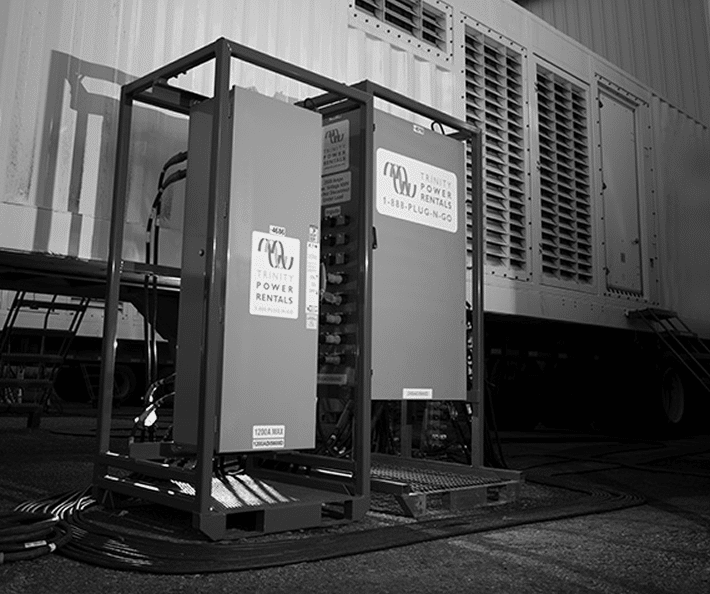- OUR APPROACH
-
COMMITTED TO YOUR SUCCESS
Our approach, developed over decades of experience, is fine-tuned to get the results you want.
We deliver concept-to-completion solutions, designed by temporary power specialists with access to the largest inventory of high-quality power generation and distribution equipment in North America.
-
- Equipment
-
RENTALS
From a wide range of diesel and natural gas generators to transformers, cable, light towers and more, our large rental fleet and extensive vendor network ensure we’ll have the temporary power equipment that your project requires — every time.

-
- Industries
-
INDUSTRIES WE SERVE
For nearly 20 years, we have been at work powering projects across Canada’s industrial sectors.
Select from this sampling of industries to learn how we can put our expertise to work for you.
VIEW ALL- Projects
- About
-
A PROUD HISTORY. A BRIGHT FUTURE.
From our inception in 1998, we have been building our team on a foundation of excellence. Our team members’ passion, expertise and commitment are what have allowed us to grow into a national company with projects across Canada.
Click on the links to learn more about our history, our team or our career opportunities.
- Blog
- Contact
-
This scalable, efficient storage solution could play an important role in the global shift to renewable energy
As governments and businesses the world over grapple with climate change, renewable energy has steadily grown in popularity and this trend seems poised to continue. The Canadian Electricity Association (CEA) explains in their 2019 Sustainable Electricity Annual Report that there are many intersecting reasons for a move towards a more sustainable energy sector in Canada (one which includes renewables): “[Federal] carbon pricing rules will have varying implications for utilities across the country based on their current electricity generation sources,” the report states. “Over the next few years, the industry will have to meet a myriad of other regulatory obligations on climate change, including coal and natural gas regulations, the clean fuel standard, and stringent carbon pricing requirements.”
Their promise of “the best of both worlds” — all the energy we need, without the carbon emissions — has made renewables such as wind and solar front runners in the race for a more sustainable energy sector. As these technologies develop and their implementation spreads, however, one key consideration threatens to hold them back: energy storage.
While storage options exist for renewable energy, most notably in the form of large batteries, these technologies face challenges from efficiency to scalability, with economic considerations at the forefront. As the CEA website explains, “The challenge so far has been to store energy economically…Economical energy storage would have a major impact on the cost of electric vehicles, residential storage units like the Tesla Powerwall, and utility-scale battery storage applications.”
Electric thermal energy storage (TES) presents an economical, efficient alternative to battery storage, with residential, commercial and industrial applications. There are a variety of different types of thermal energy storage, and while it’s not a new concept, innovative new ways of using it are generating some buzz, both for the technology’s potential to support renewable energy generation and its ability to take advantage of cost-saving opportunities that exist in the ways that power is increasingly being distributed.
This article combines reflections, research developments and predictions about thermal energy storage from government agencies, electrical organizations and industry leaders to answer the question: What is it? How does it work? And what opportunities does it represent?
Why Thermal Energy Storage?
Energy storage is a growing industry. The US Department of Energy (DOE) estimates that by 2030, global energy storage markets will be growing by 2.5 to 4 terawatt hours annually.
According to the CELCIUS project, a European initiative to support carbon-neutral municipal systems for heating and cooling, half of the total final energy consumption worldwide can be attributed to heat. This, combined with the variable nature of renewable energy generation, means that thermal energy storage has a unique potential to rise to the top in the energy systems of the future.
The DOE agrees, stating that, “Thermal Energy Storage is a critical enabler for the large-scale deployment of renewable energy and transition to a decarbonized building stock and energy system by 2050.”
According to a presentation given to the DOE’s Better Buildings Initiative, buildings where thermal energy storage has been implemented have seen a 40% peak load reduction, resulting in significant energy bill savings.
Possibly due to the electric vehicle industry and innovations such as Tesla’s Powerwall, batteries have received a great deal of attention (including research funding and market share). How does TES compare? In a discussion comparing batteries and thermal energy storage systems, CALMAC, an industry leader in thermal storage, highlights several reasons to favour TES over battery storage in commercial building contexts:
“Companies would have to make a far larger investment to match the storage and discharge capacity of a thermal energy storage installation with batteries, and this cost difference is typically what pushes facility managers toward thermal. There are a few other reasons why thermal energy storage is the right choice over batteries for commercial buildings. First and foremost is long-term ROI. While batteries may last for up to 15 years, businesses can get at least three decades’ worth of reliable performance from thermal installations like IceBank® energy storage tanks from CALMAC. Choosing thermal storage over batteries for commercial application also saves businesses the hassle of finding a way to safely dispose of lithium-ion waste materials once the service life of a battery comes to an end.” (CALMAC: “A close look at thermal versus battery energy storage for commercial applications”)
In the end, TES, like other forms of energy storage, are both the drivers and the results of a shift in our energy systems where buildings and other facilities are increasingly becoming part of the energy storage and distribution matrix – energy is not just flowing in one direction anymore.
Hot and Cold: Three Examples of TES In Action
Electric thermal energy storage works by storing energy as heat or ice, and then using that energy to heat or cool a home, building or industrial site, or to generate electricity.
One example of this technology at work in the residential sector is a home heating device that contains ceramic bricks which are “charged”, or heated at off-peak hours when electricity is cheaper, and then used to heat the home throughout the day. Sunshine Renewable Energy, a Nova Scotia-based heating system contractor describes this type of unit on their website: “An electric heating element runs between these ceramic bricks and “charges” [them]…A built-in, thermostat-controlled, forced convection heater blows the heat stored in the bricks into the surrounding room. This keeps the temperature comfortable all day long.”
Cold thermal storage uses ice to store thermal energy, rather than heat and has been successfully used in commercial facilities to augment or replace electrical cooling systems. CALMAC explains the technology on their website: “Storage mediums like ice…are extremely effective for storing and releasing large amounts of energy with minimal waste, making ice an ideal solution for helping companies take advantage of off-peak electricity…Typically this strategy is achieved by supplementing a chiller-based cooling system with thermal energy storage tanks that form and store ice.”
For the past decade, Siemens Gamesa has been developing TES technology for industrial-scale facilities. Their technology uses volcanic rocks that can be “charged” (ie: heated) either with electricity or directly with waste heat from industrial processes. The charge can last for weeks and can be used to deliver hot air at different temperature levels, or steam at different pressure levels using conventional heat exchangers. It can also be converted into electricity. In 2019 in Hamburg, Germany, Siemens Gamesa unveiled a demonstrator with a storage capacity of 130 MWh and 5.4 MWs of resistive heating charging power, which they connected to the grid.
According to Siemens Gamesa, “With close to 50% efficiency possible, TES is the most efficient low-cost energy storage solution for large amounts of energy.” The technology, “matches the demand of high-temperature processes with the fluctuating energy generation from renewable sources.” The company envisions TES as a way to convert fossil fuel plants into renewable energy storage facilities, among other applications.
TES: Where Are the Opportunities?
Applications for electric thermal energy storage range from small-scale residential units to district heating systems to multi-megawatt industrial sites. A 2018 International Energy Association (IEA) report states that “It is beginning to be recognized that thermal energy storage is an enabling and crosscutting technology that can unlock potentials in various sectors. By facilitating the coupling of the electricity and heat sectors, it is emerging as a key solution for the energy transition that improves thermal and electrical energy management flexibly and reliably.”
The same report highlights applications, developments and benchmarks for TES technologies across four sectors: district heating, non-residential buildings, industrial processes and power plants. It found that thermal storage technology was in widespread use in all sectors, with the non-residential building sector being the most recent to adopt thermal storage technology, and the industrial processes sector being the most diverse in terms of the types of TES technologies deployed and their applications.
According to the DOE, current projections show thermal energy storage capacity for buildings growing from approximately 600 MWh to 3,300 MWh over the next six years. While this growth rate is high, however, the DOE cautions that “it may take decades for TES deployments in buildings to approach present-day stationary Li-ion deployments.”
That said, advances in materials research, incentives from government agencies like the DOE and promotion by professional bodies like the CEA, which sees TES as an important piece of the sustainable energy systems puzzle, could hasten the widespread development and installation of TES systems.
As energy systems change and evolve, thermal energy storage technologies could play a key role in ensuring residential and commercial buildings, municipalities and industrial facilities can take full advantage of the opportunities these changing systems have to offer.
Related Articles
Subscribe for Access to Exclusive Content
Get insider updates, industry news, special equipment offers, and expert tips—directly to your inbox.
"*" indicates required fields






















